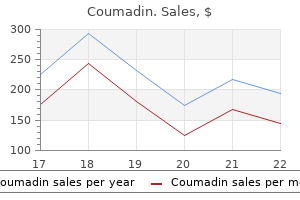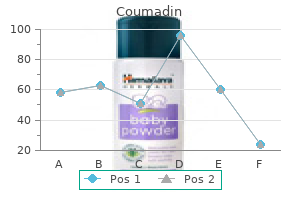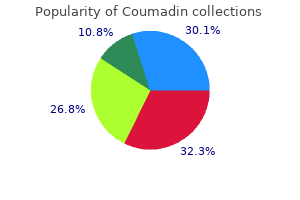





|
STUDENT DIGITAL NEWSLETTER ALAGAPPA INSTITUTIONS |

|
"Coumadin 1 mg without prescription, arteria elastica".
E. Steve, M.A., M.D., Ph.D.
Clinical Director, University of Kansas School of Medicine
Determine whether the site of infection is single/local (anatomic predisposition more likely) or multiple blood pressure medication makes me tired coumadin 2 mg with amex, and which body system(s) is/are involved arrhythmia flowchart order 2mg coumadin fast delivery. Determine if possible the type of infection and/or organism isolated in previous infections blood pressure medication joint pain coumadin 5mg free shipping. Select serum protein electrophoresis in a patient suspected of hypogammaglobulinemia hypertension 39 weeks pregnant cheap 5 mg coumadin with visa. Contrast the type of organisms likely to cause infection in patients with asplenia or hypogammaglobulinemia compared to organisms in cell mediated immune defect. Identify T cells as the mediators of specific cellular immunity, and outline how antibody production requires intact T cell number and function; discuss humoral immunity and relationship to serum immunoglobulins and measurement of specific antibody titers. Although far less common than is elevation in temperature, hypothermia (central temperature Peripheral (spinal cord transection, neuropathy, diabetes mellitus, neuromuscular disease) Key Objectives 2 Since hypothermia is a potential medical emergency, provide urgent therapy if necessary. Objectives 2 Through efficient, focused, data gathering: In patients with hypothermia secondary to acute illness, determine whether alcohol or other drugs were ingested. Contrast the advantages and disadvantages of active/passive external re-warming and active core re-warming. At very low core temperatures, a number of serious arrhythmias can occur (heart block, J wave, atrial and ventricular fibrillation). Consequently, active treatment of the hypothermic patient should not be prematurely stopped. Failure to resuscitate until re-warming has been achieved could be viewed as a "failure to meet the standard of care". Explain the mechanism of body temperature homeostasis by describing the balance between heat production and heat loss including heat generation by cellular metabolism (heart and liver) and heat loss (skin and lungs). Include a description of the role of the hypothalamic response to cold stress in order to stimulate heat production (shivering, increased thyroid/catecholamine/adrenal activity). Define the various types of heat loss: evaporation, radiation, conduction, and convection (convective heat loss to cold air and conductive heat loss to water are the most common mechanisms of accidental hypothermia). Although not usually related to serious medical problems, in some it may interfere with daily activities, affect quality of life, and in a very few be indicative of serious organic disease. Psychogenic (anxiety, depression) Key Objectives 2 Interpret for patients with tinnitus that any condition of the ear associated with the ear canal (wax, otitis media), cochlear hearing loss, or central nervous system hearing loss can cause tinnitus. Objectives 2 Through efficient, focused, data gathering: Determine whether or not the tinnitus is related to an ear condition or hearing loss. Determine whether the tinnitus is pulsatile or non-pulsatile (vascular causes tend to be pulsatile). Differentiate between drug related causes, disease related causes, and tinnitus caused by noise. Identify and counsel patients with causes of tinnitus which are relatively benign. Explain that the perception of tinnitus is likely related to the loss of input to neurons in the central auditory pathways resulting in abnormal firing. They require evaluation in the emergency department for triage and prevention of further deterioration prior to transfer or discharge. Early recognition and management of complications along with aggressive treatment of underlying medical conditions are necessary to minimise morbidity and mortality in this patient population. Lacerations and wounds from other causes Key Objectives 2 Evaluate patient according to Advanced Trauma Life Support guidelines so that airway is established and breath sounds are evaluated, the cardiovascular status is stable and peripheral and central lines are secured, neurologic status is fully documented, and with the patient completely exposed (but temperature controlled), all evidence of external injury is evaluated (secondary survey). Objectives 2 Through efficient, focused, data gathering: Elicit history from patient or collateral sources about past medical history, medications, allergies, and drug or alcohol use (present in over 30 % of patients admitted with complications of trauma). Determine whether undiagnosed traumatic injuries have been missed in the initial assessment (intracranial hemorrhage, traumatic aortic disruption, intra-abdominal injury, rhabdomyolysis). List and interpret critical clinical and laboratory findings which were key in the processes of exclusion, 2 differentiation, and diagnosis: Select diagnostic imaging (head, chest, abdomen) and other laboratory investigations. Briefly outline the process of cell division, regeneration and differentiation as it pertains to wound healing. Explain that shock is associated with systemic reduction in tissue perfusion, thereby resulting in decreased tissue oxygen delivery. Contrast pre-shock (warm or compensated shock) from distributive or low afterload shock. Rupture of a hollow viscus or bleeding from a solid organ may produce few clinical signs.

There was a 31% dropout rate in this study blood pressure medication no erectile dysfunction buy coumadin 5mg fast delivery, but among those who attended for a second biopsy at the end of the study blood pressure medication and breastfeeding cheap coumadin 1mg on line, bone histomorphometric data did not differ between the two groups blood pressure questions buy discount coumadin 1mg on-line. Both groups showed a similar decline in cognitive function over a 2-year time period heart attack japanese discount 2 mg coumadin mastercard. The plasma and bone lanthanum levels were assessed and compared as a primary end point in the study by Spasovski et al. Six weeks after the cessation of 1 year of lanthanum treatment, plasma lanthanum levels had declined to a value of 0. The mean bone lanthanum concentration in patients receiving lanthanum carbonate increased from 0. These data, together with the bone histomorphometry findings, suggested that bone lanthanum deposition was not associated with aluminumlike toxicity. Studies are needed to identify the presence and degree of phosphate additives in foods and their impact on phosphate metabolism. K Is slower progression of arterial calcification (as observed in association with the use of non-calcium-based Supplementary Table 14. Bone and plasma lanthanum levels were higher in lanthanum groups Depends on outcome Moderate Balance of potential benefits and harm: No evidence of benefit or harm on clinical and calcification outcomes. Bone histology was improved more often in lanthanum group but formal statistical comparisons were not done. Bone effects include an increased bone turnover that may be associated with marrow fibrosis and abnormal mineralization, described as osteitis fibrosa and mixed uremic osteodystrophy. K We suggest that, in patients with hyperphosphatemia, calcitriol or another vitamin D sterol be reduced or stopped (2D). It is reasonable to correct these abnormalities with any or all of the following: reducing dietary phosphate intake and administering phosphate binders, calcium supplements, and/or native vitamin D (not graded). Laboratory-based experimental data show differences in the efficacy and adverse effects of calcitriol and vitamin D analogs, but an analysis of the limited comparative studies in humans fails to show consistent differences. More recently, active vitamin D analogs, cinacalcet hydrochloride, and non-calcium- or aluminum-based phosphate binders have become available. Vitamin D the nomenclature for vitamin D has become unnecessarily complicated over the last several years, although the terms are well defined in chemical and endocrinology literature. The term vitamin D represents both vitamin D2 (ergocalciferol) and vitamin D3 (cholecalciferol). Ergocalciferol is synthesized in plants and yeasts after an ultraviolet radiation-catalyzed conversion of its precursor, ergosterol, and, together with some cholecalciferol from oily fish, is a dietary source of vitamin D in humans. However, over 90% of human vitamin D requirements come from exposure of the skin to ultraviolet-B solar radiation. Sunlight converts 7-dehydrocholesterol to previtamin D3, which undergoes a rapid, temperature-dependent isomerization to vitamin D3 or cholecalciferol. Further, 1-a-hydroxylation occurs mainly in the kidney and also at extrarenal sites. Doxercalciferol and alfacalcidol, which are 1-a vitamin D derivatives, require 25-hydroxylation by the liver for activity and are commonly referred to as `prodrugs. Vitamin D analogs to represent derivatives of vitamin D2 and vitamin D3, of which the clinically investigated synthetic derivatives include doxercalciferol, paricalcitol, alfacalcidol, falecalcitriol, and 22-oxacalcitriol (maxacalcitol). It is well known that, in humans, such a demonstration is inherently difficult, particularly when drugs such as calcium-based phosphate binders are used concomitantly. Calcimimetics Vitamin D has an established role in mineral homeostasis and musculoskeletal function and is recognized to have pleiotropic extraskeletal effects, including modulation of endothelial and immune function, inflammatory responses, and cell cycle regulation. Initially, this is related to reduced phosphate excretion and a rise in the levels of serum phosphate and fibroblast growth factor-23, both of which suppress renal 1-a-hydroxylase activity. This CaR was cloned in 1993,368 leading to a revolutionary understanding of the mechanisms by which cells adjust to changes in extracellular calcium. It is now known that the CaR is expressed in many organs controlling calcium homeostasis, including parathyroids, thyroid C cells, intestine, kidneys, and other tissues.

It is not a static and concrete thing whose true nature can be discovered and described once and for all blood pressure chart diastolic high quality coumadin 1 mg. By saying that conceptions ofpsychopathology are socially constructed rather than scientif ically derived pulse pressure damping discount coumadin 1 mg with mastercard, we are not proposing hypertension 2014 quality 2 mg coumadin, however arrhythmia tachycardia discount coumadin 1mg without prescription, that human psychological distress and suffering are not real or that the patterns of thinking, feeling, and behaving that society decides to label psychopathological cannot be studied objectively and scientifically. Instead, we are saying that it is time to acknowledge that science can no more determine the proper or correct conception of psychopathology and mental disorder than it can determine the proper and correct conception of other social constructions such as beauty, justice, race, and social class. We can nonetheless use science to study the phenomena that our culture refers to as psychopathological. We also can use the methods of science to understand the origins of the patterns of thinking, feeling, and behaving that a culture considers psychopathological and to develop and test ways of modifying those patterns. Psychology and psychiatry will not be diminished by aCkllOwledging that their basic con cepts are socially and not scientifically constructed-any more than medicine is diminished by acknowledging that the notions of health and illness are socially constructed (Reznek, 1987), nor economics by acknowledging that the notions of poverty and wealth are socially con structed. Science cannot provide us with purely factual scientific definitions of these concepts. Such disputes, however, would at least be settled on the legitimate basis of social values and exigencies, rather than on the basis ofill-defined criteria ofdoubtfol scientific status. Dimensionality of post-traumatic stress disorder symptoms in, children exposed to disaster: Results from a confirmatory factor analysis. Self-defeating behavior patterns among nonnal individuals: Review and analysis of common self-destructive tendencies. Toward a science ofmental health: Positive directions in diagnosis and interventions. Diseasing ofAmerica: How we allowed recovery zealots imd the treatment industry to convince us we are out ofcontrol. The advantages of studying psychological phenomena rather than psychiatric diagnosis. Horsefeathers: A commentary on "Evolutionary versus prototype analyses of the concept of disorder. Evidence that dyslexia may represent the lower tail of a normal distribution of reading ability. The concept of mental disorder: On the boundary between biological facts and social values. It is imperative that persons be able to commlUlicate meaningfully with one another, the primary purpose official diagnostic nomenclature is to provide this common language of communication 1975; Sartorius et aI. Every self-respecting alienist [the 19th century terTn for a psychiatrist], and certainly every professor, had his own classification" (Kendell, 1975, p. The production of a new system for classifying psychopathology became a right of passage in the nineteenth century for the young, aspiring professor. To produce a well-ordered classification almost seems to have become the unspoken ambition of every psychiatrist ofindustry and promise, as it is the ambition ofa good tenor to strike a high C. This classificatory ambition was so conspicuous that the composer Berlioz was prompted to remark that after their studies have been completed a rhetorician writes a tragedy and a psychiatrist a classification. The present condition with respect to the classification ofmental diseases is chaotic. In others the classifications used are similar in many respects but differ enough to prevent accurate comparisons. It inCluded only 22 diaglloses, which were confined largely to psychoses with a presumably neurochemical pathology. The UnitedBtates Public Health Service com:a committee, chaired by George Raines (with representations from a variety of and public health agencies), to develop a varilplt of the mental disorders section ", for use within the United States. The resulting nomenclature resembled closely the Veterans system developed by Brigadier General William Memiinger (brother to Karl 1963). Responsibility for publishing and distributing this nosology was given to , Psychiatric Association (1952) under the title Diagnostic and Statistical Manual. Nevertheless, fundamental criticisms regarding the relia validity of psychiatric diagnoses were also raised. They either use different terms for the same conqepts, or the same term for different ~(mr;;ep,ts, usually without being aware ofit.

Each taste bud contains glial-like support cells blood pressure is determined by discount coumadin 1mg visa, taste receptor cells blood pressure chart age 40 effective 5 mg coumadin, and basal cells that provide for the continual replacement of taste receptor cells that have a turnover time of 10 to 14 days pulse pressure of 80 coumadin 5mg low cost. At the base of the taste bud heart attack risk factors purchase coumadin 2 mg on line, taste afferent fibers form the postsynaptic element of a chemical synapse at the base of the taste receptor cell. Fungiform papillae: Fungiform papillae are so called because they look like button mushrooms scattered over the anterior tongue as little red bumps. It has been estimated that there are approximately 1,100 fungiform papillae per tongue. A Tongue B Papillae Circumvallate C Taste bud Outer taste pore Microvilli Epithelial cells Circumvallate Foliate Fungiform Taste buds Foliate Sensory cell Supporting cell Fungiform Basal cell Synapses Nerve Figure 21. Foliate papillae: Approximately 5 to 6 foliate papillae line each edge of the tongue just anterior to the circumvallate line. Circumvallate papillae: Vallate or circumvallate papillae are sunken papillae surrounded by a trough. The taste buds lie deep within the trough on the walls of the papillae (Figure 21. There are usually 8 to 12 papillae per tongue, but each one contains about 250 taste buds per papilla. Signal transduction for taste Taste receptor cells respond to a very large variety of molecules and encode for the five basic qualities of taste (sour, salty, sweet, bitter, and umami), distributed in different parts of the tongue (Figure 21. We now look into how these taste receptor cells can detect and then encode for the different taste qualities. Once the taste receptor cell has been depolarized, the neurotransmitter serotonin is released into the synaptic contact with the primary sensory neuron. Sour: Sour is perceived as an aversive taste unless it is combined with other flavors and tastes. The taste quality "sour" probably evolved to prevent us from eating unripe fruit or rotting foods ("that have gone sour"). Although several membrane channels have been identified that facilitate the passage of protons, the exact intracellular target that initiates the signaling, which results in synaptic transmission, is unknown. Several different ion channels have been discussed as candidates for this sodium detection, such as the epithelial sodium channel1 and the vanilloid receptor V1R. Sweet: There are a multitude of molecules that evoke the taste "sweet," and their molecular structures are very different, ranging from sugars to amino acids and peptides, to alcohols and certain salts. Smell and Taste Taste cell Sour stimulus leads to proton influx and blockade of K+ channels. These receptors are dimers of T1R2 and T1R3 receptors that have a large extracellular domain, which can bind the large variety of sweet compounds and initiate a signal transduction cascade (see below). Bitter: Compounds that elicit a bitter taste sensation far outnumber those that elicit any of the other tastes. Although most bitter tastes are unpleasant (the bitter taste likely evolved to protect us from toxins), some bitter compounds are perceived as very pleasant, especially in combination with other tastes and flavors (caffeine in coffee, bitter compounds in fruits and vegetables). Its extracellular domain can bind the various bitter compounds and initiate a signaling cascade (see below). The umami receptor occupies the same family as the sweet receptor and is a dimer of T1R1 and T1R3. There are also sensory receptors for taste in the soft palate and pharynx, but they are not thought to be as important in the appreciation of taste. Central processes from taste receptors in the tongue and soft palate enter the brainstem in the tractus solitarius to synapse on the gustatory nucleus in the rostral part of the nucleus solitarius. Smell and Taste Cortical areas of taste: Most inferior portion of the poscentral gyrus extending into the insula. Axons from the thalamus (tertiary) then project through the posterior limb of the internal capsule to the cortical area for taste, situated in the most inferior part of the sensory cortex in the postcentral gyrus, and extending on to the insula (Figure 21. It carries discriminative touch, vibration, and proprioception as well as pain and temperature. Chemicals perceived as painful are detected by the trigeminal system through its pain pathway. Some chemicals are pleasant in low doses and "taste" good but are painful at high doses.